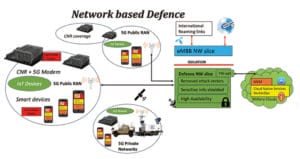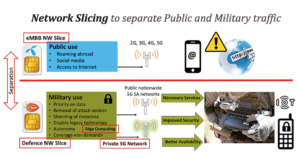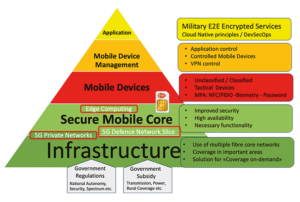Advantages of 5G from a defence perspective

Kennet Nomeland
Norwegian Defence

Military experts foresee that 5G will play an important role in future military operations, and 5G is today a hot topic in NATO. Ubiquitous connectivity, high bandwidth and low latency opens for many new use cases and military organizations all around the world are today experimenting with 5G and plan to use public 5G networks providing good coverage in combination with military-operated private 5G networks.
Ongoing 5G pilots in Norway
The Norwegian Defence has since 2018 participated in the EU-funded project 5G-VINNI coordinated by Telenor Research. In 5G-VINNI we try to adapt public 5G networks to military requirements while conforming to the standards from 3GPP as well as ETSI NFV.
A dedicated defence network slice tailored to military needs has been implemented in the 5G-VINNI pilot network. On Rygge military air station a 5G base station and an enterprise edge computing node have been installed. The Norwegian Defence is exploring 5G MIMO and beamforming capabilities. Range, capacity and robustness in both C-band and mmWave are analyzed to discover in what scenarios 5G New Radio (NR) can be useful to military use.
In September 2020, the Norwegian Defence joined a second EU-funded 5G project, FUDGE-5G. In FUDGE-5G the Norwegian Defense explores the use of private 5G networks.
What is so special about 5G?
From a technical perspective there are several areas that make 5G more interesting for military use compared to earlier generations:
5G New Radio: New frequency bands and new antenna technology are introduced with 5G NR. Massive MIMO and beamforming techniques are of particular interest for military organizations. In addition to the increased capacity that opens for many new military use cases, beamforming may also make the communication more robust against interference. The Norwegian Defence has done trials to measure range and capacity in both C-band (3,4-3,7 GHz) and mmWave (26 GHz). Recently the Norwegian Defence Research Establishment has performed electronic warfare testing to see how robust the 5G NR waveform is against intentional jamming. Integrated Access and Backhaul (IAB) was introduced in Release 16, and in 2022 we are planning to test it in our 5G pilots. We want to find out if IAB can give us a flexible solution when we want to fast extend the 5G coverage.
Network slicing makes it possible to create your own virtual network on the same physical infrastructure of a public 5G network. With a dedicated network Slice, you can set your own security policy, priority mechanism, etc. In the 5G-VINNI pilot Telenor Research created a dedicated Defence network Slice with focus on security and where the traffic has been completely isolated from any public or Internet traffic. Roaming has also been disabled. To achieve maximum separation and control of the metadata we have configured a separate 5G Core in the Defence Network Slice. A firewall with Machine Learning capabilities that monitors the traffic and other security functions is applied to the Defence Slice.
IMSI-Catching: Researchers have previously demonstrated how an attacker may use an IMSI catcher to obtain the identity of a subscriber in the form of an International Mobile Subscriber Identity (IMSI) in 4G networks. In 5G standalone (SA) networks it is possible to eliminate the threat from IMSI catchers by using the Subscription Concealed Identifier (SUCI) instead of IMSI. Together with our partners we have verified that when a phone is locked to 5G SA, it will not expose the IMSI. A closed Defence Slice running in a public network may be set up in a mode called 5G SA support only. Practically, this will be possible in a few years from now when Dynamic Spectrum Sharing (DSS) provides a seamless 5G experience of 5G NR in all frequency bands. In addition, SA support is needed in the military handsets, and roaming outside Norway must be blocked. In a commercial eMBB slice this will be difficult, hence this is a good example of the possibilities we have with network slicing.
Autonomy: Edge computing means installing datacenters at the edge of the network close to the users. Using edge computing nodes, it is possible to achieve local autonomy in strategically important areas. In the 5G-VINNI pilot we have a dedicated edge inside Rygge Air Station. This edge is running a complete 5G core network as well as selected application functions. Even with outage of backhaul (both fiber and satellite communication) to the central 5G Core data center in Oslo, the pilot can still provide full autonomy and provide military services to the users in the airbase.
In the FUDGE-5G project we address private 5G networks. A private autonomous 5G network is installed on a trailer (Cell on Wheels) so the armed forces can establish 5G in local areas of interest. From a network perspective we want to utilize both private and public 5G networks, and from a service perspective we want to test how we can utilize both centralized military clouds, 5G and edge computing nodes to create better and more robust services.

How a combination of private and public 5G networks could serve military needs in the future
Securing 5G for military use
Securing 5G for a military use is complex. We need experts in 5G radio, cloud technology and security. In 5G-VINNI and FUDGE 5G the Norwegian Defence Material Agency is working closely with Telenor Research, the Norwegian National Security Authority and the Norwegian Defence Research Establishment. We have adopted an agile methodology where we perform tests and demonstration and learn as we go, since the learning curve is steep.
Military organizations have in general good mechanisms to ensure confidentiality and integrity of the data before sending it over a commercial network. An important principle to secure confidentiality in 5G networks is multiple layers of encryption terminating in different places. The encryption provided by 5G (SIM card + IPsec encryption in the transport from the gNodeB to the 5GC) is terminated in the 5G network. Application-level encryption and VPN can add additional security beyond what is provided by the 5G network.
Control of terminals via mobile device management solutions and control of the operating system in the smart devices is also important, if the user equipment is used for classified information.
Modern smartphones support multi-factor authentication (MFA) that is currently not supported by traditional military Combat Net Radios (CNR). A combination of something you know (e.g. password), something you have (e.g. NFC card/ FIDO support) and something you are (e.g. biometry) is today possible on a smartphone.
No military organization will “put all the eggs in one basket” and solely depend on 5G. To be able to communicate in all kinds of scenarios, military organizations will always have different ways of communicating, like satellite communication and CNR. However, we believe that 5G can be used in many scenarios such as in collaboration with public safety agencies. The Norwegian Defence often participates in missions related to natural disasters, refugee crises, terrorism, pandemic diseases, etc. Hybrid warfare targets the whole society, not just the military. The need to collaborate in the public safety context is more crucial than ever. With the use of 5G networks, collaboration between public protection and disaster relief agencies and the Norwegian Defence will be easier.
To secure high availability of the public mobile networks, the Norwegian government provides funding to ensure robust transmission, power-supply and 5G coverage also in rural areas. In the future an increasing part of the critical communication in the society will traverse public 5G networks. In 2023 the area coverage of public 5G networks in Norway will reach 90%.

The figure illustrates how military and public traffic is separated by network slicing

Securing 5G for military use is complex and it requires competence in many areas
Conclusion
5G provides many advantages over previous generations and we will soon see use of 5G also in military organizations. The 5G projects 5G-VINNI and FUDGE 5G are giving the Norwegian Defence a unique insight in the 5G possibilities and limitations. The main focus for the Norwegian Defence at the moment is to create a target architecture where network slicing, edge computing and private 5G networks will be part of the solution to secure the mobile value chain. Securing 5G for military use will be a continuous work that will never end so that a long-term collaboration with the private commercial stakeholders endures long into the future.
Further information
5G-VINNI project – https://www.5g-vinni.eu
FUDGE-5G project – https://fudge-5g.eu